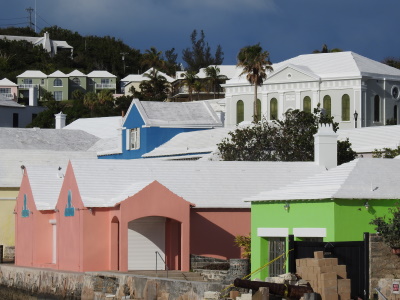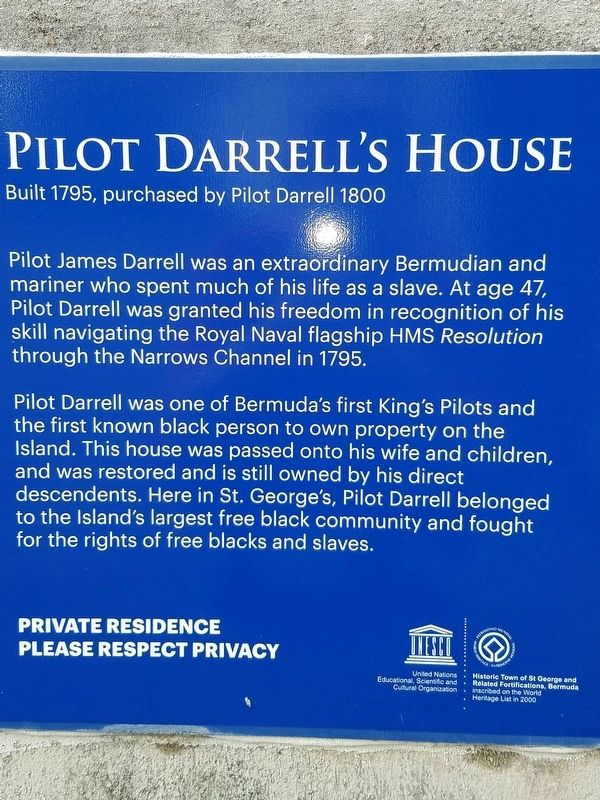St. George, Bermuda

The Historic Town of St George and Related Fortifications, Bermuda is the earliest example of an English colonial town in the New World.
It consists of the Town of St George and fortifications on small islands commanding access to the Town and the harbour. Permanent settlement here began in 1612. The forts are authentic examples of the first defensive works built by early European colonists.
Community Perspective: the town is very quaint and looks a bit like an open-air museum for tourists. The best of the forts is Fort St. Catherine, which houses an interesting museum.
Map of St. George, Bermuda
Community Reviews
Els Slots

I recently amended my WHS coverage strategy from purely looking for the hotspots to also going out of my way twice a year for a difficult/expensive WHS (expecting that when I get older I will have more time to travel, but physical challenges will get harder and the money less easily replenished). An odd one among the latter set of WHS is St. George, Bermuda – one of our most isolated WHS (it’s 1,200km from Independence Hall). The island group of Bermuda is not a particularly hard destination to reach, but it is mostly visited from the US or via a cruise. From Europe, there’s only one British Airways flight a day. And it surely ticks the “expensive” box: start from the UK price level, add a logistical surcharge as most things have to be flown in, take the cruise ship price inflation into account, and finally the American-style 15-20% tipping. In the end, this ‘tick’ cost me some 1,500 EUR.
The WHS is located on and around one of the northernmost islands of the Bermuda archipelago: St. George Island. The town is known as “St. George’s” (short for St. George’s Town), but it seems to have lost its “’s” in the official WHS name: The Historic Town of St. George and Related Fortifications, Bermuda. Note also the addition of “Bermuda” at the end – there are so many towns called St. George around the world that the Bermudians probably wanted it to be clear that their St. George was honored.
I stayed for 3 nights in a B&B in St. George, in the core zone. So I walked straight into the historic center of St. George from my front door. In 'my' street I found already a beautiful house with all the characteristics of the unique architecture of Bermuda: colorfully painted, with a stepped roof so rainwater can be collected, a chimney and curved stairs (“welcoming arms”) giving access to the property.
The historic center is fairly authentic: 65% of the houses date from before 1900, and another 40% of them from before 1800. Most buildings have been given a contemporary purpose: they’ve been turned into shops, restaurants, and hotels - though without giving them a too commercial feel. The oldest stone building on the island is the State House from 1621. Here the parliament of Bermuda met until 1825. It is now owned by a local Masonic lodge. It was constructed in a very different style from the rest of the town center, it reminded me a bit of Angra do Heroismo in the Azores.
When I was done with the town, I started on a walk around St. George’s Island. Forts have been built here over the centuries at various strategic places at the coast and on islands off the coast. 23 of them are included in the WHS as separate locations. I just walked on the main road: there is so little traffic that it is easy to do.
The first fort that I came across is Gates Fort. A fort stood on this tip of land as early as 1626. Later a 2-story guard house was added. It’s just a tiny outpost that wouldn't have withstood any serious attack. The Alexandra Battery lies not much further along the coast. This defense work is a lot newer: most of what is on display now comes from 1904. The terrain is partly overgrown and the cannons are rusty. Just as with Gates Fort, a tourist doing the forts loop on a scooter and myself were the only ones visiting.
The largest fort lies on the north side of the island: Fort St. Catherine. You can see it from afar. Getting there on foot requires a long detour: part of the coastal route has been closed off because they are building a large hotel annex apartment complex. A caretaker of the fort that I spoke to later was seriously angry about it: what a disdain for this historic stretch of coast, including the beach where the first Englishmen came ashore!
Fort St. Catherine has been converted into a museum. After paying 7 USD, I followed the route through the complex. It goes mostly underground, giving you a good idea of how the logistics of an active fortress work. Bullets and gunpowder were stored in cellars and were hoisted when needed to the firing guns.
The exhibition also tells about the lives of the British soldiers who were sent here. Certainly the earlier ones were not really given a lot of priority within the Empire: there was even a group that was left to fend for themselves for 13 years or so, until another ship came along with their replacements. The fortifications around St. George guarded access to the British naval port and shipyard on the main island, now the Royal Naval Dockyard. Upon inscription it was advised by ICOMOS to add the Dockyard to the nominated area as an extension, but that never materialized.
Read more from Els Slots here.
Klaus Freisinger

St. George is known as the oldest continuously inhabited English settlement in the New World, and it is to the English-speaking Americas what Santo Domingo is to the Spanish-speaking part - the site of many "first" and "oldest" superlatives. E.g., St. Peter's Church is the oldest Anglican and Protestant Church in the Western Hemisphere. The State House dates from 1620 and is the oldest building on the islands. The capital was moved to Hamilton in the early 19th century, and today St. George is very quiet and looks a bit like an open-air museum for tourists. It is very well preserved and does a lot to highlight its WH status. Included in the site are several fortifications, some of which are just a short walk from the town and can be visited. The best of these is Fort St. Catherine, which houses a very interesting museum. I also went to nearby Alexandra Battery and Gates Fort, both of which can be visited easily in a pleasant walk from St. George. There is also a fine museum on Bermudian history in the Royal Naval Dockyard on the other end of the island, but this is not part of the WHS. Bermuda is mostly visited by Americans and Canadians, and there is only one flight connection to Europe (British Airways to London). I went there for a short stopover of 3 days after a trip to the US, which was very pleasant and convenient. Otherwise, it could easily be visited on one of the many cruise ships that stop there.
Ben Pastore
For an Atlantic island, Bermuda feels much more like the Caribbean, and the related fortifications reflect as much. This small yet lovely island is usually crawling with tourists, but that's no problem. There always seems to be some corner with the solitude and charm that Bermuda exudes.
Emilia Bautista King
The Town of St. George is very quaint and the townspeople are very welcoming. The place is filled with old world English charm with its cobblestone streets and old buildings. The related fortifications entail the forts that surround St. George. Some of them are not accessible to the public, but my husband and I managed to visit Fort St. Catherine, Fort George, Alexandra Battery and Gate's Fort. These places are walking distance from the town.
We visited Bermuda for four nights, which was enough time for me. December 2006 was when we were there and it was not very busy with tourists. Personally, I quite liked it this way and I still enjoyed pleasant weather!
Community Rating
Site Info
- Full Name
- The Historic Town of St George and Related Fortifications, Bermuda
- Unesco ID
- 983
- Country
- United Kingdom
- Inscribed
- 2000
- Type
- Cultural
- Criteria
-
4
- Categories
- Urban landscape - Colonial
- Link
- By ID
Site History
2000 Inscribed
Site Links
Unesco Website
Official Website
Related
In the News
Connections
The site has 18 connections
Art and Architecture
Constructions
Geography
History
Timeline
Trivia
WHS Names
WHS on Other Lists
World Heritage Process
Visitors
86 Community Members have visited.
The Plaque
 (external source)
(external source) (external source)
(external source)